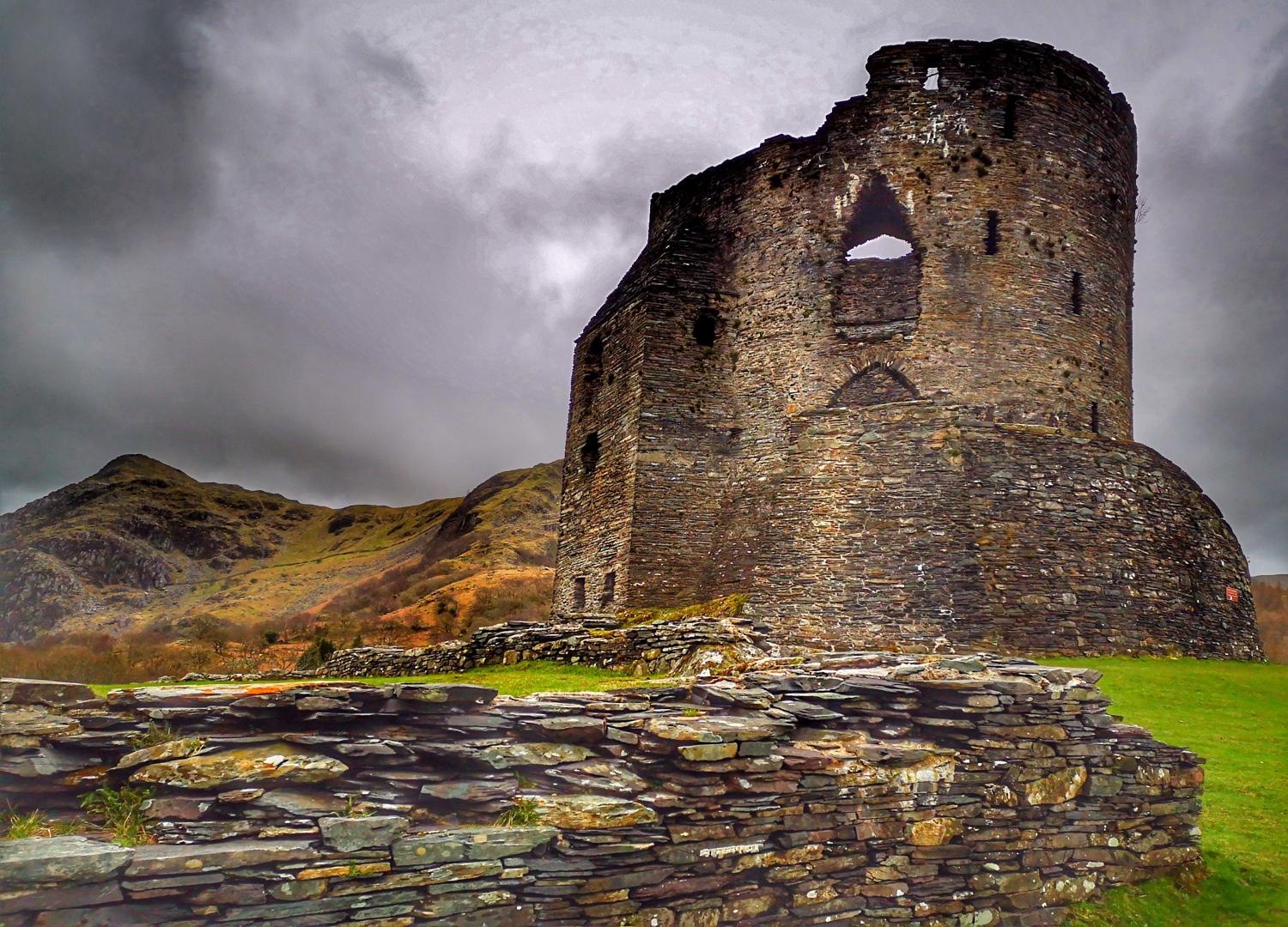
Construction first began on Dolbadarn Castle in 1230 AD under the rule of the great Welsh prince Llywelyn the Great.
History and Origins of Dolbadarn Castle
Seeking to consolidate his power across North Wales, Llywelyn chose an ideal location to build a castle to control the Llanberis Pass, an important mountain pass connecting Caernarfon and southern Snowdonia.
The earliest fortification constructed was likely a simple timber structure, allowing the castle to be built quickly as a means of defense. Yet over time, Dolbadarn Castle evolved into a substantial stone-built castle, befitting its role as an administrative center for Llywelyn’s kingdom. Its formidable keep and round corner towers still stand as evidence of the castle’s medieval Welsh origins, despite later additions by English conquerors.
Perched atop its rocky hillside overlooking the azure waters of Llyn Padarn, Dolbadarn Castle has long been a symbol of power and prestige in this mountainous region. For over 200 years, it served as a stronghold for a succession of Welsh princes before falling into English hands in the 13th century. Nevertheless, its majestic ruins continue to tell the story of its founders and its strategic place in Welsh history.
Architecture and Layout
The imposing ruins of Dolbadarn Castle reveal much about its important strategic role in medieval times. At its heart stands the tall stone keep, which had three floors containing a great hall, private chambers, and battlements. Unusually, round towers occupy the corners of the keep, adding extra defense and architectural flair.

Surrounding the keep is a lower outer ward, protected by a ringwork of walls and ditches. Within this outer area were found service buildings like the kitchen, stables, and chapel, allowing the castle to operate as a self-sufficient stronghold. The sea was also connected to the castle by a small canal, allowing supplies to be brought directly by boat.
Despite its partial ruin today, key architectural elements point to Dolbadarn’s sophisticated defense system. The round towers allowed defenders to shoot arrows in all directions. A massive gatehouse controlled entry through the outer curtain wall. And the keep’s slit windows offered ideal vantage points.
The innovative design and strategic layout of Dolbadarn Castle provide insight into both its role in regional power struggles and the evolution of defensive castle architecture. Walking amongst these impressive stones today, one can readily imagine archers atop the soaring towers and daily life within the walls.
Later Use and Abandonment
For over 200 years after its initial construction in 1230 AD, Dolbadarn Castle served as an important stronghold for Welsh princes. Its control of the Llanberis Pass made it a prized possession. But in 1283, Dolbadarn fell to English royal forces led by King Edward I during his conquest of North Wales.
Under English control, Dolbadarn Castle continued to play a strategic role. Its troops could suppress any uprising in nearby Snowdonia. The fortress also became useful as a prison for high-status captives. During a revolt in 1405, the famous Welsh rebel Owain Glyndŵr was briefly imprisoned at Dolbadarn.
Yet Dolbadarn Castle’s significance eventually declined in more peaceful times. After Owain Glyndŵr’s rebellion ended in the early 1400s, the need for such a mountain fortress waned. By 1550, historical records suggest Dolbadarn Castle was largely abandoned and had fallen into a state of disrepair. With other castles proving more useful, the former Welsh stronghold was left to crumble amidst the Snowdonia hills.
Today those majestic stone ruins stand as a monument to Dolbadarn’s earlier role in Wales’ struggle for independence from England. Although long unoccupied, the castle continues to symbolize the medieval history of this region. Its abandoned towers and walls will likely remain immersed in legend and lore for centuries to come.
Current Status and Tourism
Since coming under the protection of Cadw, the Welsh government’s historic environment service, the ruins of Dolbadarn Castle have become an accessible and popular destination for visitors to Snowdonia National Park. As one of the area’s most picturesquely situated castles, Dolbadarn attracts photographers eager to capture its dramatic setting.
Tourists can explore the castle ruins at their leisure, admiring the soaring keep and panoramic views from atop the stone walls. Information signs explain key parts of the site and its history, bringing its past alive. Paths winding through the grounds also lead to scenic walks around Llyn Padarn lake or along a nearby nature trail.
In many ways, the majestic backdrop of the ruined castle defines the beauty of Snowdonia itself. The Welsh name “Dolbadarn” appropriately translates to “meadow of the Lords.” Sitting peacefully amidst its scenic mountain landscape, Dolbadarn Castle remains a monument to the princes who once ruled this region.
Though now only a quiet tourist stop, Dolbadarn still conjures up visions of the medieval kingdom and storied history of North Wales. Its towering presence serves as a window into that era, when castles marked the seats of power across the land.
How to find Dolbadarn Castle
Map to Dolbadarn Castle Map and directions
Dolbadarn Castle address Dolbadarn Castle, A4086, Llanberis, Gwynedd, Wales, LL55 4UB, United Kingdom
Places to stay
Related Articles
Related Articles
The Middle Ages in England
The Middle Ages in England span from around 500-1500 AD, covering over 1000 years of English history.
Uncovering the Hidden Histories of England and Wales’ Overlooked Castles
Many lesser-known castles around England and Wales have their own unique histories that are fascinating to uncover.
5 Facts About the Tower of London
Discover the rich history and secrets with these 5 fascinating facts about the Tower of London, a symbol of royal power and intrigue for centuries.





